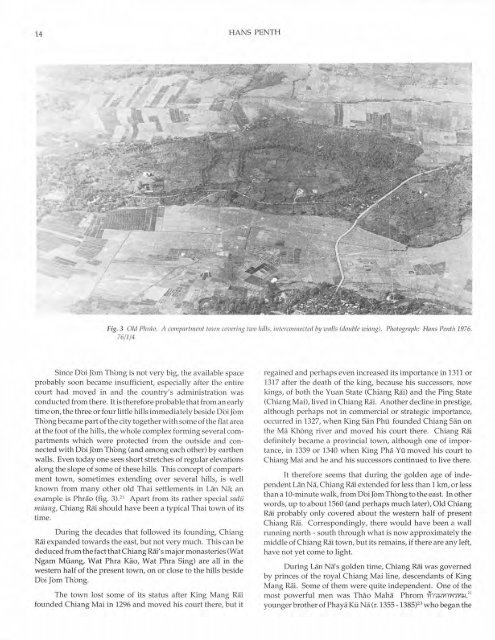The Journal of the Siam Society Vol. LXXVII, Part 1-2, 1989 - Khamkoo
The Journal of the Siam Society Vol. LXXVII, Part 1-2, 1989 - Khamkoo
The Journal of the Siam Society Vol. LXXVII, Part 1-2, 1989 - Khamkoo
You also want an ePaper? Increase the reach of your titles
YUMPU automatically turns print PDFs into web optimized ePapers that Google loves.
14 HANS PENTH<br />
Fig. 3 Old Phrifo. A COIIIJ.Inrtlllent town covering two hills, interconl/ected by wa lls (do 11ble wia11g). Photograph: Ha ns Penth 1976.<br />
76(1/4<br />
Si nce Obi Jom Thong is not very bi g, <strong>the</strong> available space<br />
probably soon became insufficient, especially after <strong>the</strong> entire<br />
court had moved in and <strong>the</strong> country's administration was<br />
conducted from <strong>the</strong>re. It is <strong>the</strong>refore probable that from an early<br />
time on, <strong>the</strong> three or four little hills immediately beside Obi Jbm<br />
Thong beca me part <strong>of</strong> <strong>the</strong> city toge<strong>the</strong>r with some <strong>of</strong> <strong>the</strong> flat area<br />
at <strong>the</strong> foot <strong>of</strong> <strong>the</strong> hills, <strong>the</strong> whole complex forming several compartments<br />
which were protected from <strong>the</strong> outside and connected<br />
with Obi Jbm Thong (and among each o<strong>the</strong>r) by ear<strong>the</strong>n<br />
walls. Even today one sees short stretches <strong>of</strong> regular elevations<br />
along <strong>the</strong> slope <strong>of</strong> some <strong>of</strong> <strong>the</strong>se hills. This concept <strong>of</strong> compartment<br />
town, sometimes extending over several hills, is well<br />
known from many o<strong>the</strong>r old Thai settlements in Uin Na; an<br />
example is Phrao (fig. 3). 21 Apart from its ra<strong>the</strong>r special snd(i<br />
munng, Chi ang Rai should have been a typica l Thai town <strong>of</strong> its<br />
time.<br />
During <strong>the</strong> decades that followed its founding, Chiang<br />
Rai expanded towards <strong>the</strong> east, but not very much. This can be<br />
deduced frvm <strong>the</strong> fact that Chiang Ra:i' s major monasteries (Wa t<br />
Ngam Miiang, Wat Phra Kao, Wat Phra Sing) are all in <strong>the</strong><br />
western half <strong>of</strong> <strong>the</strong> present town, on or close to <strong>the</strong> hills beside<br />
Obi Jbm Thong.<br />
<strong>The</strong> town lost some <strong>of</strong> its status after King Mang Rai<br />
founded Chiang Mai in 1296 and moved his court <strong>the</strong>re, but it<br />
regained and perhaps even increased its importance in 131 1 or<br />
1317 after <strong>the</strong> death <strong>of</strong> <strong>the</strong> king, because his successors, how<br />
kings, <strong>of</strong> both <strong>the</strong> Yuan State (Chiang Rai) and <strong>the</strong> Ping State<br />
(Chiang Mai), lived in Chiang Rai. Ano<strong>the</strong>r d ecline in prestige,<br />
although perhaps not in commercial or strategic importance,<br />
occurred in 1327, w hen King San Phu founded Chiang San on<br />
<strong>the</strong> Ma Khong river and moved his court <strong>the</strong>re. Chiang Rai<br />
definitely became a provincial town, although one <strong>of</strong> importance,<br />
in 1339 or 1340 when King Pha Yu moved his court to<br />
Chiang Mai and he and his successors continued to live <strong>the</strong>re.<br />
It <strong>the</strong>refore seems that during <strong>the</strong> golden age <strong>of</strong> independent<br />
Lin Na, Chiang Rai extended for less than 1 km, or less<br />
than a 10-minute walk, from DbiJom Thong to <strong>the</strong> east. In o<strong>the</strong>r<br />
words, up to about 1560 (and perhaps much later), Old Chiang<br />
Rai probably only covered about <strong>the</strong> western half <strong>of</strong> present<br />
Chiang Rai . Correspondingly, <strong>the</strong>re would have been a wall<br />
running north- south through what is now approximately <strong>the</strong><br />
middle <strong>of</strong> Chiang Rai town, but its remains, if <strong>the</strong>re are any left,<br />
have not yet come to light.<br />
During Uin Na' s golden time, Chiang Rai was governed<br />
by princes <strong>of</strong> <strong>the</strong> royal Chiang Mai line, d escendants <strong>of</strong> King<br />
Mang Rai. Some <strong>of</strong> <strong>the</strong>m were quite independent. One <strong>of</strong> <strong>the</strong><br />
most powerful men was Thao Maha Phrom Yll"l:J.JVIl'Yi'l'VI:J.J."<br />
younger bro<strong>the</strong>r <strong>of</strong> Phaya Kii Na (r. 1355- 1385)2 3 who began <strong>the</strong>

















